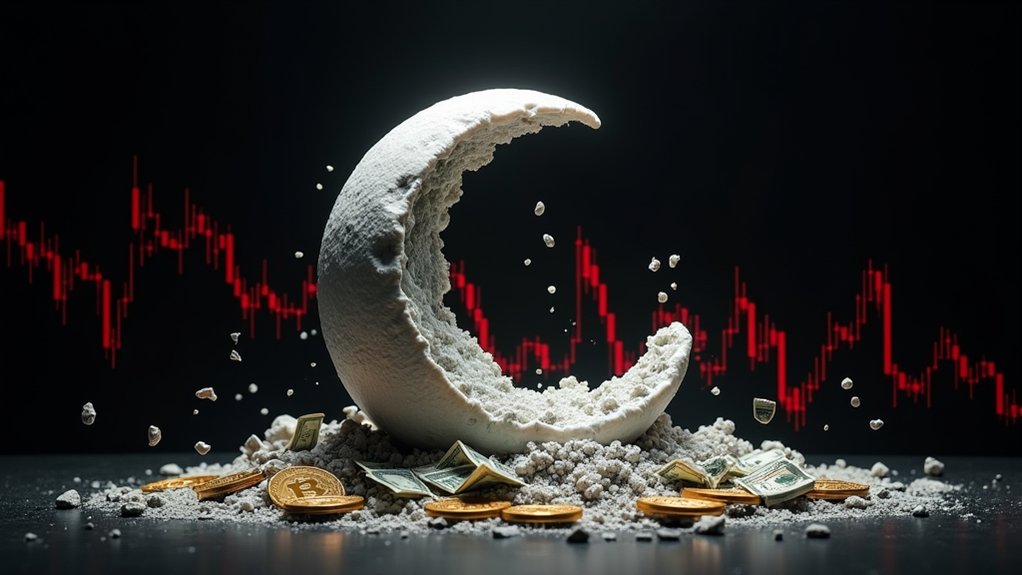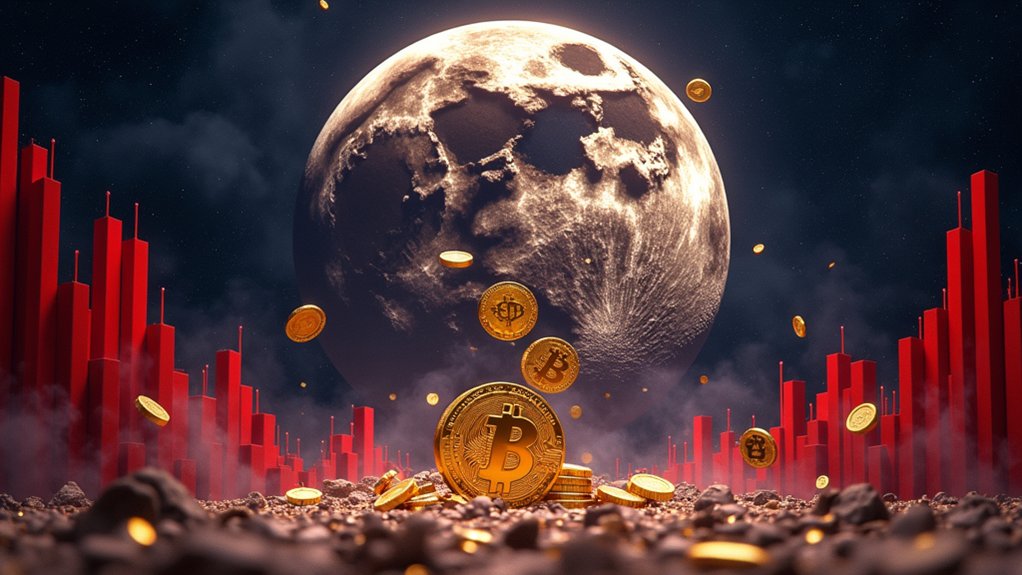Terra's LUNA cryptocurrency collapsed catastrophically in May 2022 when its sister stablecoin UST lost its $1 peg. The burn-mint mechanism between LUNA and UST, designed to maintain stability, instead triggered a death spiral that erased nearly $40 billion in value. LUNA plummeted from $80 to virtually zero within days, while UST fell to $0.35. The blockchain was ultimately halted on May 12, leaving over 280,000 investors with substantial losses. Further exploration reveals complex systemic vulnerabilities behind this implosion.

While algorithmic stablecoins had previously been regarded as theoretical experiments in decentralized finance, Terra's UST and its native token LUNA emerged as the first comparable system to achieve significant market adoption, before suffering a catastrophic collapse in May 2022 that wiped out approximately $60 billion in value.
The ecosystem, which progressed from a South Korean payments application into a complex financial structure, centered on UST, an algorithmic stablecoin designed to maintain a $1 peg through a burn-mint mechanism with LUNA, the network's governance token.
Terra's prominence was largely driven by Anchor Protocol, a DeFi application offering unsustainable 19.5% annual yields on UST deposits, which attracted $14 billion in assets before the ecosystem's downfall.
The Luna Foundation Guard, established to support UST's stability, had accumulated approximately 80,000 Bitcoin worth $3.5 billion by early 2022, creating an illusion of robust backing for the stablecoin's peg.
The collapse began on May 5, 2022, when significant liquidity movements in Curve Finance's UST pool caused the stablecoin to slip from its dollar peg to $0.986.
This initial depeg triggered a cascading series of events, with large UST holders rapidly exiting their positions and precipitating a liquidity crisis that saw UST plummet to $0.35 by May 9, while LUNA's value crashed from $80 to virtually zero.
Critics had long pointed out that the system's vulnerability lay in its reliance on arbitrage traders to maintain the peg, which functioned well only during market uptrends.
The blockchain was ultimately halted on May 12 as validators attempted to prevent governance attacks amid LUNA's hyperinflation.
The aftermath revealed disproportionate impacts on retail investors, particularly in South Korea where over 280,000 individuals collectively lost more than $28 billion.
The collapse demonstrated that wealthier investors were typically able to exit first, leaving those with less market sophistication to bear the brunt of the losses.
Following the collapse, Terra relaunched as Terra 2.0 on May 28, abandoning the algorithmic stablecoin model entirely, while the original chain was renamed Terra Classic with its tokens redesignated as LUNC and USTC.
The crisis prompted intensified regulatory scrutiny of stablecoin mechanisms globally, with authorities implementing stricter reporting requirements and oversight mechanisms to prevent similar catastrophes in the future.
Frequently Asked Questions
Could Luna Make a Comeback in the Future?
Luna's comeback faces significant challenges, including the enduring stigma of its catastrophic collapse, regulatory scrutiny, and limited functional utility.
While community-driven initiatives like token burns may gradually reduce supply, structural issues persist in Terra Classic's infrastructure.
LUNC could experience price fluctuations during broader bull markets, but sustainable recovery would require rebuilding institutional trust, resolving technical debt, and establishing genuine use cases beyond speculative trading.
Who Profited From Luna's Collapse?
Various actors profited from LUNA's collapse, including short sellers who placed significant bets against the token, market manipulators like Tai Mo Shan who earned $123 million through unregistered transactions, arbitrageurs who exploited the LUNA/UST mechanism during de-pegging phases, and insiders with advance knowledge who liquidated positions early.
These entities capitalized on systemic vulnerabilities, leveraging their financial resources and market insights to extract value while Terra's ecosystem imploded.
Are There Legal Consequences for Luna's Founders?
Terra's founders face significant legal repercussions, with Do Kwon confronting seven federal charges including securities fraud, potentially carrying a 50-year sentence.
Following extradition battles between the U.S. and South Korea, Kwon awaits trial scheduled for January 2025, having pleaded not guilty.
Regulatory actions include a $4.5 billion settlement with Terraform Labs and SEC civil charges regarding unregistered securities offerings, while Jump Crypto received a $123 million penalty for misleading claims about UST stabilization.
How Did Luna's Crash Affect Other Cryptocurrencies?
Luna's crash triggered a devastating contagion effect across cryptocurrency markets, with Bitcoin declining approximately 50% and Ethereum falling 23% in the six months following.
The collapse precipitated institutional failures at Three Arrows Capital, Celsius Network, and Voyager Digital, while eroding investor confidence in algorithmic stablecoins broadly.
Additionally, Luna Foundation Guard's liquidation of $3.5 billion in Bitcoin reserves to defend UST's peg further depressed prices, exacerbating the broader crypto market downturn.
What Regulatory Changes Resulted From Luna's Downfall?
Luna's downfall triggered significant regulatory developments, including the Stablecoin Transparency Act requiring issuers to maintain non-digital reserves with monthly audits.
The Stablecoin Innovation and Protection Act mandated 100% FDIC-insured reserves.
Enforcement actions intensified, with SEC fines against Tai Mo Shan and criminal charges against Terraform Labs founder Do Kwon.
Regulators globally coordinated efforts to enhance stablecoin oversight, while debates between CFTC and SEC jurisdiction over digital assets intensified considerably.









